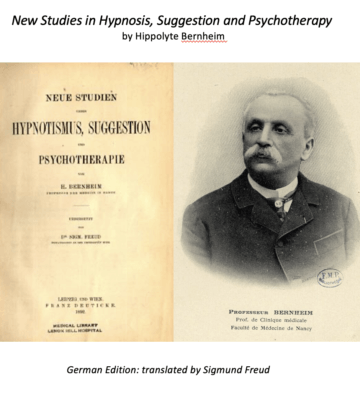- Last Updated
- Posted by
- Hypnotherapy

This is the german edition translated by Freud and one of his earliest contributions to psychiatry. Freud was very much impressed with Bernheim:
“I went to Nancy in the summer of 1889 where I spent several weeks. I witnessed the astonishing experiments performed by Bernheim on his hospital patients, and it is there that I experienced the strongest impressions relating to the possible use of powerful psychical processes which remained hidden from human consciousness. I had many interesting discussions with him and I undertook to translate into German his two works on suggestion and its therapeutic effects”
History and Origins of the term “psychotherapy”
Many people consider that the term psychotherapy was first used with regard to Freud’s psychoanalysis. However this is incorrect.
The term psychotherapy was first used with regard to hypnosis and suggestive therapeutics.
It later became deliberately separated from hypnosis (as the word had become tainted by showmen and charlatans).
The idea that psychoanalysis is the original psychotherapy is more due to the efforts and public relations aspect of the psychoanalytic community than what actually took place. Not only did hypnosis give birth to psychoanalysis, it was also the original psychotherapy – and Freud proposed returning to hypnotic suggestion in his final writings.
It was Daniel Hack Tuke, an early English advocate of hypnotherapy and great-grandson of the Quaker who founded the famous York Retreat, who had made some initial use of the term “psychotherapy” in his writings in 1872.
However, it was effectively introduced to widespread use in the fields of medicine and psychology by Hippolyte Bernheim and the followers of his “Nancy school” of therapy, at the end of the late nineteenth century. (“Nancy school” of therapy relates to Bernheim’s therapeutic activities at the University of Nancy in France, near Luxembourg and Strasbourg).
Bernheim used the term specifically to describe hypnotherapy, and wrote, e.g.,
‘to provoke this special psychic state by hypnotism and to exploit it with the aim of cure or of relief […] this is the role of the hypnotic psycho-therapeutic.’ (1886: 218).
Historians believe that the very first use of the word “psychotherapy” in a book title came a few years later in the English hypnotist Charles Lloyd Tuckey’s Psycho-therapeutics, or Treatment by Hypnotism & Suggestion (1889).
Tuckey popularised the use of the word “psychotherapy” as a synonym for the hypnotherapy of the Nancy school. In his “history and bibliography of psycho-therapeutics”, Tuckey writes,
To James Braid, the Manchester surgeon, is due the credit of having seen the germs of truth which lay hidden and obscured in the writings of Mesmer and the animal magnetisers. […] Although he publicly demonstrated his system of healing – which he practised with much success – and wrote several works upon the subject, it appears to have died with him, and it remained for Dr. Liébault to arrive at the truth of psycho-therapeutics.
(Lloyd Tuckey, 1889: xi)
“Psychotherapy: The invention of word”
This specific issue was recently investigated on behalf of the The Wellcome Trust Centre for the History of Medicine by the researcher and Jungian scholar Sonu Shamdasani whose conclusions are published in ‘Psychotherapy: The invention of a word’ in History of the Human Sciences, 2005 (vol. 18, no. 1).
Shamdasani writes:
“For Bernheim, the use of suggestions not only featured prominently in his practice, it formed the theoretical key to understanding hypnosis and a general psychology of the mind. Hypnosis was understood as a state of heightened suggestibility, akin to sleep. He defined suggestion widely, as the act by which an idea is accepted in the brain.
For Bernheim and the Nancy school, suggestive therapeutics consisted in the deliberate manipulation of credence, belief and expectation under the rubric of suggestion and autosuggestion in the treatment of a wide range of psychological and physical conditions. In addition to functional neuroses, Bernheim claimed that it was effective in cases of paralyses, contractures, insomnia, muscular pain, hemiplegia, paraplegia, rheumatism, anaesthesia, gastric disorders, neuralgia and sciatica.
For Bernheim, the common factor active in religious healing as well as in many therapeutic practices, was suggestion:
“In the waking state credence is increased by religious faith (religious suggestion, miraculous cures), and by faith in medicines or medical practices (cure by fictitious medicines, magnets, metals, electricity, hydrotherapeutics, the tractors of Perkins, massage, the system of Mattei, &c.). The idea of cure suggested by these practices may cause the psychical organ to act and obtain from it the curative effect, not that the sum total of these practices is suggestion, but that suggestion is a factor in every one of them.”
Shamdasani continues:
“The making of psycho-therapeutics synonymous with hypnosis and suggestion [by Bernheim] meant that the word became widely disseminated. ‘Psycho-therapeutics’ rode on the back of the burgeoning hypnotic movement. “(Loc cit.)
He adds,
“For Bernheim and his followers, as psychotherapy was identified with hypnotic and suggestive therapies, the history of psychotherapy was identical with that of the latter.“
Following on from Bernheim and Tuckey’s introduction of the term we begin to see “psychotherapy” used more widely with a clear chronology.
In 1887, Frederik van Eeden and Albert Willem van Renterghem, two Dutch physician’s in opened a clinic in Amsterdam for “suggestive therapy”. In 1889 they renamed their clinic, having visited visited Bernheim in his clinic, and were impressed by what they had witnessed, the ‘clinique de psycho-thérapeutique suggestive’.
In 1892 at the second congress of experimental psychology in London Van Eeden explained the rationale behind the choice of the term
“In 1889 we chose psychotherapy as a collective name to refer to this treatment, and we thus name all therapy which cures by the intermediary of the psychic functions of the patient. The priority of the term goes back to Hack Tuke.
We add the word ‘suggestive’ because suggestion – understood in the sense of Bernheim – plays the principal role in our therapy.
We avoid the words ‘hypnotism’ or ‘hypnosis’ deliberately. As for myself, I would prefer that one did not use these words when concerning psychotherapy. The unreasonable use of these words ha[s] given rise to preconceptions, to confusion and misunderstandings. “
“Psychotherapy” moves away from “hypnosis”
We now start to see the move away from “hypnotic suggestion” and towards the idea of the psychotherapy of suggestion separate from hypnosis.
Bernheim took up the word ‘psychotherapy’ as the title of his work,
Hypnotisme, suggestion, psychothérapie: études nouvelles
[Hypnotism, Suggestion, Psychotherapy: New Studies] in 1891.
Freud himself translated the German edition – this was one of Freud's earliest contributions to psychiatry and he was deeply impressed by his visits to Bernheim's clinic writing:
“I went to Nancy in the summer of 1889 where I spent several weeks. I witnessed the astonishing experiments performed by Bernheim on his hospital patients, and it is there that I experienced the strongest impressions relating to the possible use of powerful psychical processes which remained hidden from human consciousness. I had many interesting discussions with him and I undertook to translate into German his two works on suggestion and its therapeutic effects”
Bernheim with a remarkably modern psychological perspective had begun to say that hypnosis was nothing but suggestion and this led to further distance between hypnosis and the growing use of the term “psychotherapy”
In 1892 at a scientific congress in London Bernheim stated “There is no hypnotism, there is only suggestibility”
« Il n'y a pas d'hypnotisme, il n'y a que de la suggestion »
As Shamdasani writes
“Bernheim and the Nancy school had stressed that hypnosis consisted in heightened suggestibility, and not in a separate state. In the early 1890s, Delboeuf drew the radical conclusion that hypnosis did not exist, or, in other words, that ‘the power of hypnotism consists above all in the very word of hypnotism, because [the subject] does not understand it well’.31 The dissolution of hypnosis had the effect of promoting the word ‘psychotherapy’. Delbouef noted ‘from the point of view of scientific exactness, the term psychotherapy, or better still, of psychodynamic, is much preferable’.32
With the word ‘hypnosis’ falling into disrepute, psychotherapy offered itself as a ready alternative. Unlike hypnosis, it was free of controversial connotations. Having come to prominence due to the rise of the hypnotic movement, the word ‘psychotherapy’ now benefited from the decline of hypnosis, and through its capacity to be dissociated from it.”
There was always a concern that the subject did not understand what hypnosis was and was being influenced by the physician and the suggestive meanings of the word.
Shamdasani concludes:
“But could one say that subjects understood the word ‘psychotherapy’ any better? Was the power of psychotherapy similarly bound up with the suggestive effect of the word itself? “
With time the meaning of “psychotherapy” was gradually widened to encompass the rational “persuasion” methods of Paul Dubois and his followers and the psychoanalytic methods of Freud’s disciples. Gradually it became more and more generic in meaning, covering an incredibly diverse range of concepts and techniques. In recent decades, it has been estimated that there are over 600 distinct models of psychotherapy.
As various branches of psychotherapy diverged from their roots in hypnotherapy they quickly evolved into a myriad of autonomous schools of thought. However, over the decades what became split off was often re-assimilated back into clinical hypnotherapy, as hypnotists learned from other branches of psychotherapy.
Freud himself concluded that finally it might be necessary to add hypnosis to psychoanalysis stating
“It is very probable, too, that the application of our therapy to numbers will compel us to alloy the pure gold of analysis plentifully with the copper of direct [hypnotic] suggestion.”
Much more recently Irving Kirsch writes,
A century ago, hypnotherapy often consisted of a hypnotic induction, followed by suggestions of symptom removal. Consequently, hypnotherapy has been viewed by some writers as a mode of therapy that might be compared with psychodynamic, cognitive-behavioural, or other therapeutic approaches. However, suggestions for symptom relief play a relatively minor role in contemporary hypnotherapy. Instead, hypnotherapy generally consists of the addition of hypnosis to some recognised form of psychotherapy. (Kirsch et al., 1995: 214)
Consequently, hypnotherapy, clearly the first major school of psychotherapy, gave birth to most other branches of psychotherapy, and has evolved alongside its cousins into an increasingly sophisticated and integrative discipline. It is nevertheless common nowadays to distinguish between “hypnotherapy”, which mainly uses direct suggestion and other simple interventions, and “hypno-psychotherapy” (for example “cognitive behavioural hypnotherapy) which has assimilated more theory and technique from other branches of psychotherapy, although it is often very difficult to distinguish the two things in practice.
References:
Sonu Shamdasani (2005). Psychotherapy: the invention of a word- History of the Human Sciences 2005 18: 1 DOI: 10.1177/0952695105051123
Kirsch, I., Montgomery, G. & Sapirstein, G. (1995). Hypnosis as an adjunct to cognitive-behavioral psychotherapy: A meta- analysis. Journal of Consulting and Clinical Psychology, 63: 214–220.

